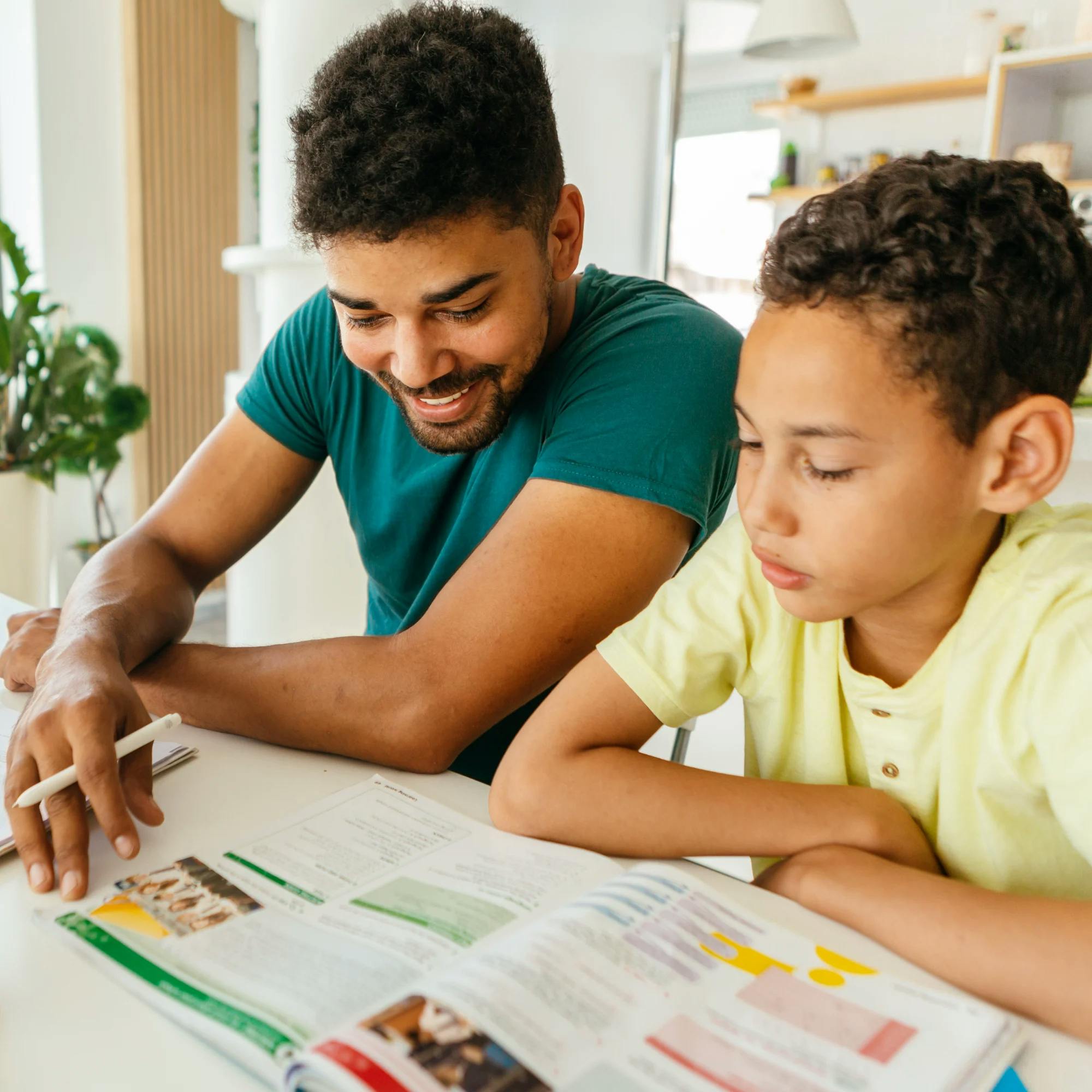
7 Tips for Improving Your Child’s Reading Comprehension
 Leanne Sherred, M.S., CCC-SLP
Leanne Sherred, M.S., CCC-SLP
The ability to comprehend written text is one of the most important life skills for young brains. Reading can open the mind and stimulate the imagination, and it's important for classroom and professional success. However, reading comprehension doesn’t come easily or naturally for many children. They may find it hard to understand what they read, make connections between the text and their existing knowledge, think deeply and critically about concepts, and draw conclusions. When this happens, it can bring on feelings of frustration and hopelessness. Your child may even resist the act of reading altogether.
What is reading comprehension?
Reading comprehension goes beyond simply answering the question “What happened?” Understanding and decoding text, while also using reasoning and critical thinking, can help your child:
Tell facts versus fiction
Determine why some story characters are mean, funny, or sad
Understand what caused a specific event to happen
Consider what will happen next in the story
One common misperception is that children who are “good readers” are “good comprehenders.” In fact, often children who are able to read well still struggle to grasp the meaning of what they've read. This is because reading comprehension isn’t just a single skill, but a collection of important developmental skills that must be improved together in order for the child to make progress.
Let’s start by reviewing what skills are involved in reading comprehension.


Important reading comprehension skills
There are a number of critical language, memory, and reasoning skills that can contribute to reading comprehension problems, including:
Language abilities: Strong language abilities are closely linked to reading comprehension outcomes. Vocabulary is one example. Children must have a large working knowledge of different vocabulary words to understand verbal and nonverbal language, including written text. They need to know word definitions not just in isolation (such as repeating the definitions with flashcards), but also within the context of the written word.
Children who have some type of developmental language disorder are generally more likely to struggle with reading comprehension.
Working memory: Your child’s cognitive abilities and working memory are important. Working memory refers to the short-term memory we use to temporarily hold information, apply logic, and make decisions. For example, children with poor working memory may spend lots of time trying to decode the connections between letters and sounds. That leaves them little time to grasp and retain what they just read.
Attention: We’ve all “zoned out” during reading, and then realized we remember very little of what happened on the page. The words may be clicking in our heads, but they’re not sticking. For children who have short attention spans or become easily distracted, this can contribute to poor reading comprehension.
For example, studies have shown that children with ADHD, which can affect a person’s ability to focus and pay attention, perform worse at reading comprehension tasks compared to children without ADHD.
Processing speed: This refers to the speed it takes for a person to complete tasks with accuracy. This can range from visual tasks (such as naming colors, letters, or numbers) to verbal tasks (such as answering questions or summarizing information). Children who display slower processing speed may have a harder time understanding the words they read or answering open-ended questions about the text.


How to help your child improve reading comprehension
There are many strategies you can use with your child to improve their reading comprehension. Like all language-based skills, you may not see progress magically overnight--it takes practice and persistence. However, using these techniques regularly with your child will increase their comprehension over time and set them up for academic success. You can use this handy list of tips to make reading more fun and enjoyable for your child as well.
1 Read aloud
When children read books aloud, this can naturally force them to slow down. They’ll have more time to process information on the page, which can increase their retention and comprehension.
2 Make connections
Whenever you can help your child connect what they read to their personal experiences, it can help them focus. For example, if a character in the book travels to a beach, remind your child of a time your family traveled to the shore. Over time, have your child proactively make these connections themselves. Additionally, use the outside world to help children get more meaning from the text. Does your child love reading about sports? If so, watching or attending a sports game can help them bring these real-world connections to life.
3 Reread books
Many children enjoy rereading books they love. Sure, this can be somewhat numbing for parents and caregivers, but it’s actually a fantastic comprehension-building technique. Rereading books will help your child familiarize themselves with the story, decode words, and gain insight from the text. It will also help improve their fluency by encouraging them to read quickly and smoothly.
4 Read books at the right skill level
Choose books that are appropriate for your kiddo's reading level--ones that aren’t too difficult. As a rule of thumb, your child should know the definitions of 80% to 90% of the vocabulary words within the story. If they’re confronted with too many unrecognizable words, or are stopping often to try and interpret words, it can detract from their focus and comprehension.
5 Ask open-ended questions
While you don’t want to constantly interrupt your child, find opportunities throughout the story to ask questions. Try to ask open-ended questions that can’t be answered with a simple yes or no, which will encourage them to think through their answers. For example, instead of asking, “Was that character sad?” you can say, “Why was the character sad?” This helps your child to verbally process the information they’ve just read. You can also encourage reading comprehension by asking questions before, during, and after reading the book. For example:
Before: Why do you want to read this book? What do you think this book is going to be about?
During: What do you think will happen next? Why is that character upset?
After: What was the book about? Did you like the book? Did the book remind you about something that has happened to you?


6 Practice inferencing
Inferencing is an important development skill that requires combining information you already know to make predictions about the future. This is a wonderful way to have your child apply logic to the story in order to improve comprehension. For example, if a character is red-faced and yelling, we can infer they’re angry. If they have red eyes, a runny nose, and are sneezing, we can infer they’re sick.
7 Provide check-ins
It never hurts to take a quick pause during reading to check for understanding. You can do this during parts that are more complicated or have bigger vocabulary words, or if you notice your child getting stuck. If they’re struggling, encourage them to reread the section and try to summarize what happened.
What if your child is still struggling with reading comprehension?
If your child is struggling with reading, writing, or spelling, consider seeking professional help from a speech-language pathologist. Speech therapy can help children learn to better process information, understand verbal and nonverbal language, and improve their comprehension skills.
Your speech therapist will use a host of different techniques and strategies with your child. They'll also give you at-home exercises you can use to continue building this foundational, life-long skill. Increasingly, many families are turning to online speech therapy to receive the same personalized, high-quality care with the added benefits of being more affordable, convenient, and accessible.
How Expressable Can Help
Concerned your child isn't reaching age-expected milestones? Looking for communication support from a professional? Expressable is a national online speech therapy practice serving children and adults. We treat all major areas of communication and feeding, offer flexible hours including evenings and weekends, and accept most major health insurance plans. We’re proud to have earned more than 3,000 5-star reviews from our clients (4.9/5 average).
Our therapy model is centered on parent and caregiver involvement. Research proves that empowering caregivers to participate in their loved one’s therapy leads to better outcomes. That’s why we combine live, 1-on-1 speech therapy with personalized education and home practice activities for faster progress.
Communication is more than words. It’s how we share how we feel and show who we are. We’re here to help you or your child do just that.









